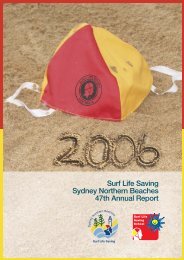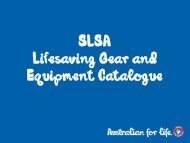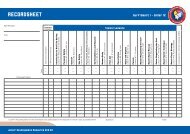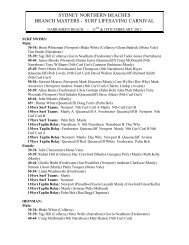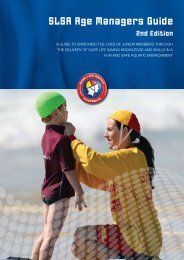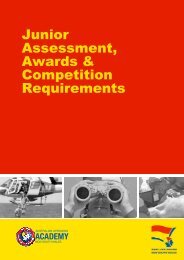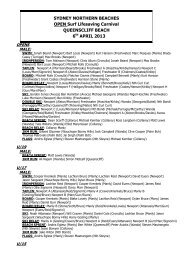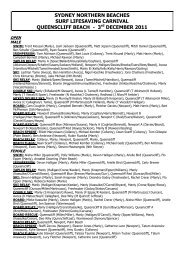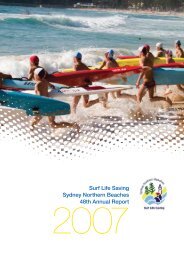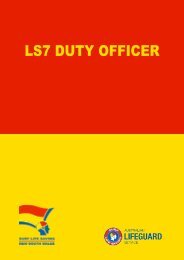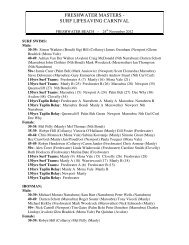Critical Incident Debrief Flow-Chart - Surf Life Saving NSW
Critical Incident Debrief Flow-Chart - Surf Life Saving NSW
Critical Incident Debrief Flow-Chart - Surf Life Saving NSW
Create successful ePaper yourself
Turn your PDF publications into a flip-book with our unique Google optimized e-Paper software.
ACKNOWLEDGEMENTS<br />
This document is intended for use by <strong>Surf</strong> <strong>Life</strong> <strong>Saving</strong> Duty Officers, Emergency Coordinators and other<br />
delegated Officers.<br />
This document was produced by <strong>Surf</strong> <strong>Life</strong> <strong>Saving</strong> New South Wales. SLS<strong>NSW</strong> would like to acknowledge the<br />
partnership of <strong>NSW</strong> Police, the Australian <strong>Life</strong>guard Service and AccessEAP in supporting this program.<br />
<strong>Surf</strong> <strong>Life</strong> <strong>Saving</strong> New South Wales<br />
3 Narabang Way, Belrose <strong>NSW</strong><br />
PO Box 307, Belrose <strong>NSW</strong> 2085 Australia<br />
PH +61 (02) 9471 8000<br />
Fax +61 (02) 9471 8001<br />
E experts@surflifesaving.com.au<br />
W www.surflifesaving.com.au<br />
ABN 93 827 748 379<br />
© <strong>Surf</strong> <strong>Life</strong> <strong>Saving</strong> New South Wales 2010
Contents<br />
<strong>Critical</strong> <strong>Incident</strong> <strong>Debrief</strong> Overview..................................................................................page 4<br />
Section 1: Operational <strong>Debrief</strong>.......................................................................................page 5<br />
Section 2: Emotive <strong>Debrief</strong>............................................................................................page 5-7<br />
Appendices<br />
Appendix 1-<strong>Critical</strong> <strong>Incident</strong> <strong>Debrief</strong> Log:..................................................................page 8-13<br />
Appendix 2-<strong>Critical</strong> <strong>Incident</strong> Audit Form:.................................................................page 14-20<br />
Appendix 3-Notification of Injury Form:...................................................................page 21-23<br />
Appendix 4-WorkCover Form:...................................................................................page 24-29<br />
Appendix 5-Witness Statement Form: .................................................................... page 30-33
Overview<br />
Purpose<br />
It is the aim of this document to bring together or reference all relevant procedures/processes and<br />
provide consistent and structured delivery of effective <strong>Critical</strong> <strong>Incident</strong> <strong>Debrief</strong>ing.<br />
What is a „<strong>Critical</strong> <strong>Incident</strong>‟?<br />
The environment in which surf life saving operates has the potential for members to be involved in<br />
serious incidents of a high-intensity and traumatic nature, and which do often involve death, serious<br />
injury and/or significant risk to lifesaving personnel. These are referred to as ‘critical incidents’.<br />
Generally critical incidents are defined by surf life saving as either (or a combination of the following:<br />
<br />
<br />
<br />
<br />
<strong>Incident</strong> resulting in death (incl successful CPR, body recovery)<br />
<strong>Incident</strong> resulting in serious/major injury<br />
<strong>Incident</strong> whereby a member of SLS is seriously injured<br />
<strong>Incident</strong> whereby a member of the public is injured by lifesaving personnel/equipment<br />
In such cases a <strong>Critical</strong> <strong>Incident</strong> <strong>Debrief</strong> (as outlined in this document) should be undertaken within<br />
the RECOVERY PHASE of the incident.<br />
Why should a <strong>Critical</strong> <strong>Incident</strong> <strong>Debrief</strong> be undertaken?<br />
A critical incident debrief is undertaken to ensure that:<br />
1) Member welfare/support is optimised<br />
2) The ability to re-establish core lifesaving services is achieved<br />
3) Obligatory paperwork and data is recorded, collected and forwarded appropriately<br />
4) The <strong>Surf</strong> <strong>Life</strong> <strong>Saving</strong> response is documented for future review or for legal reasons (if required)<br />
5) <strong>Surf</strong> <strong>Life</strong> <strong>Saving</strong> is best positioned (through effective data collection) to provide drowning<br />
prevention recommendations to the Coroner and relevant local government authorities.<br />
Who should deliver/lead <strong>Critical</strong> <strong>Incident</strong> <strong>Debrief</strong>?<br />
The Branch Duty Officer (or equivalent) should lead every <strong>Critical</strong> <strong>Incident</strong> <strong>Debrief</strong> as part of the<br />
incident Recovery Phase. If a Duty Officer is not available an appropriate Branch or Club Officer<br />
should be tasked to deliver the debrief by the Branch Duty Officer.<br />
When/where should a <strong>Critical</strong> <strong>Incident</strong> <strong>Debrief</strong> be undertaken?<br />
As soon as possible after the incident has finished, at a location which does not require much travel<br />
(i.e the SLSC). The debrief should be conducted in a secure room, with no thoroughfare and isolated<br />
from any media or public interference.<br />
Who should attend?<br />
All SLS personnel who were involved in the incident should attend, regardless of the level of<br />
involvement. Delivery of the debrief ASAP is important in this respect to ensure full attendance. Any<br />
personnel not in attendance should be recorded in the debrief form for further contact if necessary.<br />
External agency / public involvement<br />
A joint SLS-External agency debrief can be organised following or at a later date, involving the key<br />
senior members involved (Duty Officer, Patrol Captain, Senior <strong>Life</strong>guard, Police Sgt etc).
What is involved in a <strong>Critical</strong> <strong>Incident</strong> <strong>Debrief</strong>?<br />
The critical incident process can be broken into two separate parts:<br />
1) Operational <strong>Debrief</strong><br />
2) Emotive <strong>Debrief</strong> (Psychological First Aid)<br />
3) Expert Counseling (as required post incident )<br />
1. Operational <strong>Debrief</strong><br />
The Duty Officer shall lead/coordinate the Operational <strong>Debrief</strong> and record member involvement (who<br />
was involved and in what capacity), contact details and the sequence of events - from first notification<br />
through to the end of the incident. Key actions and timings are recorded as best able within the<br />
sequence of events.<br />
Contributing factors to the incident, positive/successful parts of the response and/or issue/concerns<br />
are discussed and documented.<br />
The relevant and appropriate forms/logs should be completed in full and forwarded to the necessary<br />
officers by the Duty Officer; these are:<br />
Log/Form Completed By When Completed (reason) Notes<br />
<strong>Debrief</strong> Form Duty Officer All <strong>Critical</strong> <strong>Incident</strong> <strong>Debrief</strong>s Sent to Branch DOL<br />
Patrol Log Patrol Captain All patrols Copy sent to Branch DOL<br />
<strong>Incident</strong> Log<br />
Patrol Captain or All critical incidents<br />
Copy sent to Branch DOL<br />
Duty Officer<br />
Witness Statement Form Member For any criminal incident<br />
Sent to Branch DOL<br />
<br />
<br />
For any incident where SLS<br />
personnel have been seriously<br />
injured<br />
Where a member of the public has<br />
been injured by surf lifesaving<br />
personnel/equipment<br />
A witness statement form<br />
should be completed by<br />
members individually<br />
under the<br />
supervision/support of the<br />
Duty Officer.<br />
As per form instructions<br />
Workcover Form Member Where a member has received an<br />
injury<br />
<strong>Critical</strong> <strong>Incident</strong> Audit Form Duty Officer All critical incidents Sent to Branch DOL<br />
Additional forms can be downloaded and printed from www.surflifesaving.com.au<br />
2. Emotive <strong>Debrief</strong> (Psychological First Aid)<br />
<strong>Critical</strong> incidents can have a strong emotional impact, which can overwhelm the usually effective<br />
coping skills of the individual or group. Members may experience a number of different reactions to a<br />
critical incident, all of which are completely normal. Psychological First Aid (Peer Support) focuses on<br />
member wellbeing and coping, and will form a significant part of the duty officer role when dealing<br />
with critical incidents.<br />
The Duty Officer shall lead the Emotive <strong>Debrief</strong> session, and in essence the first part of can<br />
commence (covertly) within the operational debrief, specifically in the emotive debrief the Duty Officer<br />
will:<br />
<br />
<br />
<br />
<br />
<br />
Observe and record any members displaying obvious emotional trauma<br />
Outline the effects that traumatic events can have on people (straight away and delayed on-set)<br />
Outline what support is available and how to access it (hotline, counselling sessions)<br />
Provide supporting information (brochures, contact information)<br />
Outline the process ‘from here’ as far as follow-up, accessing additional support etc<br />
Note: Additional trained ‘Peer Support’ Officers may be used to deliver this session if required (i.e if<br />
the Duty Officer is not available or has not been trained/resourced)
Supporting Resources and Counselling Options<br />
Resource Details Availability<br />
Brochure – Information<br />
for Duty Officers<br />
Brochure – <strong>Critical</strong><br />
<strong>Incident</strong> Peer Support<br />
Service<br />
Information for Duty Officers and Peer<br />
Support Officers<br />
Information for members and their<br />
families/friends<br />
From Duty Officer or Peer Support<br />
Officer<br />
From Duty Officer or Peer Support<br />
Officer<br />
AccessEAP Hotline 1800 818 728 Free call 24/7<br />
AccessEAP Counselling<br />
Session<br />
AccessEAP Website<br />
1-on-1 counselling session<br />
Ph: 1800 818 728<br />
For more information of trauma and<br />
support options<br />
www.accesseap.com.au<br />
Free service<br />
Organised by the member of their<br />
family<br />
Free web based information<br />
3. Expert Counseling (AccessEAP)<br />
SLS<strong>NSW</strong> has a contract with a private counselling organisation called AccessEAP.<br />
AccessEAP plays the following roles in SLS <strong>Critical</strong> <strong>Incident</strong>s:<br />
<br />
<br />
<br />
<br />
<br />
Provision of trauma information/brochures<br />
Provision of free 24/7 counselling hotline to members<br />
Provision of psychological first aid (emotive debrief) training to Branch Duty Officers and Peer<br />
Support Officers<br />
Provision of group counselling sessions for significantly traumatic critical incidents<br />
Provision of ‘follow-up’ individual counselling session for members<br />
Accessing AccessEAP Counsellors<br />
Same-day counselling session<br />
If a significantly traumatic incident occurs, a AccessEAP Counsellor can be requested to attend the<br />
<strong>Critical</strong> <strong>Incident</strong> <strong>Debrief</strong> to deliver a group counselling session (replacing the emotive debrief session).<br />
This can be requested by the Duty Officer (or delegated Officer) by contacting AccessEAP on 1800<br />
818 728<br />
Note: Availability will depend on location and availability of a counsellor.<br />
Individual Counselling Session (post-incident)<br />
Members (or their parents) can request an individual counselling session as they deem necessary by<br />
contacting AccessEAP on 1800 818 728<br />
4. Follow Up Welfare Check<br />
As the symptoms of trauma on members can present themselves some time after the incident, It is<br />
important that the Branch Duty Officer involved, Branch Director of <strong>Life</strong>saving, Club Captain and Club<br />
President communicate post-incident to discuss the event and the need to ensure that the members<br />
involved are monitored and provided ongoing support (if required).
<strong>Critical</strong> <strong>Incident</strong> <strong>Debrief</strong> <strong>Flow</strong>-<strong>Chart</strong><br />
During Patrol Hours<br />
After-Hours Response<br />
Patrol deals with incident as per training<br />
and resources available<br />
Duty Officer Coordinate’s response<br />
Attends scene if able or responds other<br />
Duty Officer or delegated Officer<br />
<strong>Surf</strong>Com coordinates ambulance/<br />
helicopter/police/other support<br />
Callout teams/services responded as<br />
required<br />
Branch Duty Officer (or delegated officer)<br />
responds to the incident and provides<br />
support as required through RESPONSE<br />
and RECOVERY PHASE<br />
<br />
<br />
<br />
<br />
Advises (as able):<br />
Branch Duty Officer<br />
Branch Director of<br />
<strong>Life</strong>saving<br />
13SURF<br />
Club Captain<br />
Branch Duty Officer (or delegated officer)<br />
responds to the incident and provides<br />
support as required through RESPONSE<br />
and RECOVERY PHASE<br />
1. Runs operational group<br />
debrief for all involved<br />
2. Delivers the emotive group<br />
debrief for all involved<br />
Record who, when, where, how, why<br />
details. Using <strong>Critical</strong> <strong>Incident</strong><br />
<strong>Debrief</strong> template<br />
Provides brochures and support<br />
information<br />
Duty Officer follows steps 1-6<br />
for <strong>Critical</strong> <strong>Incident</strong> <strong>Debrief</strong><br />
3. Ensures all paperwork<br />
is completed<br />
4. Completes <strong>Critical</strong> <strong>Incident</strong><br />
Audit<br />
With photos if able<br />
5. All paperwork forwarded to<br />
Branch DOL<br />
Within 48hours<br />
Service Response<br />
Duty Officer Response<br />
6. Branch DOL contacted & briefed<br />
State DOL, <strong>Life</strong>saving Manager,<br />
Club Captain, Club President briefed<br />
ASAP
CRITICAL INCIDENT DEBRIEF LOG<br />
Name of Facilitator (Duty Officer):<br />
Time:<br />
Date:<br />
Location:<br />
Introduction<br />
Preparation<br />
Are you dressed neat and tidy and in an appropriate shirt or polo?<br />
<strong>Debrief</strong> should take place in a quiet room/area – secure from thoroughfare/media/public?<br />
Do you have the required forms/logs/paperwork?<br />
Are all members involved in attendance?<br />
Any junior members involved – have their parents been invited (if able)<br />
Welcoming Address<br />
Your address to the assembled people involved will include:-<br />
<br />
<br />
<br />
<br />
<br />
<br />
<br />
Your name and position within the organisation<br />
A brief and relevant personal surf background<br />
That the debrief will take around 1hour and be split into 2 parts (operational and emotive debrief)<br />
The purpose of the debrief is:<br />
- Ensure all paperwork and information completed<br />
- Record key actions/times/sequence of events for internal records, police records, possible coronial inquests and<br />
media (to ensure professional and correct information is available from SLS)<br />
- Record all members involved and provide traumatic counselling information and support if required<br />
What will happen with information given at debrief?<br />
- Recorded internally as per SLS logs and <strong>Surf</strong>Guard. Provided externally to <strong>NSW</strong> Police or Coroner (if requested)<br />
specific member information will not be disclosed to any other person or organisation outside of SLS<strong>NSW</strong> and the<br />
Club, without their prior agreement (i.e Media).<br />
Ask permission to record the debrief (if able) - the tapes disclosure will be treated in the same way as any notes taken<br />
from the debrief<br />
Reinforce that the purpose of the debrief is not to apportion blame, but record the facts.<br />
Record of Attendance<br />
# Name Phone Email Witness Statement<br />
Required? Y/N<br />
1<br />
2<br />
3<br />
4<br />
5<br />
6<br />
7<br />
8<br />
9<br />
9<br />
10<br />
11<br />
12<br />
13
Establish the facts<br />
Date of <strong>Incident</strong><br />
Time of <strong>Incident</strong> (Start)<br />
Type of Activity<br />
Number of Patients<br />
Did anyone witness patient prior?<br />
Exact Location<br />
Tide<br />
Weather<br />
Wind Strength<br />
Wind Direction<br />
Swell - Wave Size<br />
Head Count (at time of incident)<br />
Number on Patrol (bronze)<br />
Number of <strong>Life</strong>savers Assisting<br />
Number of Public Assisting<br />
Nature of Public Assisting<br />
Nature of Others Assisting<br />
Determine the sequence and nature of events<br />
Get the group talking about the incident from when and how the incident was first identified/communicated?<br />
Explore the situation and encourage everybody to talk through their involvement.<br />
This may take some time as you establish who, when, how many/much, for how long, assistance by others, and handover to<br />
others…<br />
Add further lines if necessary - more information is better than less information. Use an additional pad if necessary.<br />
Be conscious of outspoken individuals ‘leading’ the conversation – ask specific members their recollections and thoughts as<br />
required.<br />
Time<br />
(approx)<br />
What Happened?<br />
First notification:
Involvement Summary<br />
Who did what? (e.g IRB Driver, , First Aid Provider, Defibrillator, Crowd Control etc)<br />
Write down and summarise all known people and their involvement in the incident (they may have more than one role)<br />
1<br />
Name<br />
Role / Involvement<br />
2<br />
3<br />
4<br />
5<br />
6<br />
7<br />
8<br />
9<br />
10<br />
11<br />
12<br />
13<br />
<strong>Incident</strong> Summary<br />
Agree amongst all involved on a brief written statement can be written of what happened without worrying about why it<br />
happened<br />
If you were to summarise in a couple of sentences how would you do so?
Measure of Change<br />
Open a discussion on how the incident went from a lifesaving perspective (good and requiring improvement)<br />
Identify if practical measures could be taken for improving lifesaving responses in the future.<br />
Identify what other factors (outside SLS control) may have contributed and what measures might prevent a repeat in the future<br />
(i.e. signage at beach access).<br />
Emotive <strong>Debrief</strong><br />
Introduction<br />
Outline that this session and follow-up options for support are all about protecting our members and helping ensure they<br />
continue to be involved in SLS and the impacts of the incident are minimised.<br />
Outline that it is ok to ask for help and additional counselling sessions should be organised for anyone who thinks they might<br />
benefit from it.<br />
Trauma effects<br />
Open a discussion on the effects a traumatic incident can have on all members (the young/inexperienced and old/experienced<br />
alike).<br />
Explain that everyone responds differently in the aftermath of a critical incident and that it is completely normal to be affected in<br />
some way.<br />
Explain that symptoms can fall into four areas: Behavioural, Physical, Cognitive and Emotional.<br />
Some of the symptoms to watch for are:<br />
Significant changes in an individual’s social and professional functioning<br />
Marked symptoms of anxiety: restlessness, irritability, anger.<br />
Avoidance behaviour (avoiding communication, activities, places and people associated with the incident).<br />
Withdrawal from others: loss of motivation<br />
Appearing like ‘being in a daze’<br />
Appearing preoccupied or emotionally ‘flat’<br />
Difficulties with concentration, attention and decision making<br />
Teariness, fatigue<br />
Exaggerated ‘startle response’<br />
Increased alcohol consumption<br />
Explain that these effects may not occur immediately but may occur in the weeks and months following the incident.<br />
Support Available<br />
1. Information pamphlets – hand these out to everyone<br />
2. Website information www.accesseap.com.au<br />
3. Free 24/7 Access Counselling Hotline 1800 818 728<br />
4. Free Individual Counselling Session (locally) – member or their family can call 1800 818 728
Explain that through the WorkCover forms should be filled out today, to eliminate any paperwork should counselling be<br />
requested in the future.<br />
Discuss with the Club Captain or Club President for a follow up to occur with each member to ascertain how they are coping<br />
with the situation.<br />
Use below to list any members that you feel may need closer attention when a follow up occurs.<br />
Member Identified For Further Follow Up<br />
<strong>Critical</strong> <strong>Incident</strong> <strong>Debrief</strong> Checklist<br />
‘<strong>Debrief</strong> Form’ completed in full<br />
All personnel involved recorded with contact details– including those who may not be at debrief<br />
‘<strong>Incident</strong> Log’ completed in full and copy attached<br />
‘Patrol Log’ completed in full and copy attached<br />
Any ‘Witness Statement Forms’ (individual) are completed attached<br />
(for criminal incidents or incidents where serious member injury or public injury caused by SLS has occurred)<br />
‘Notification of Injury/WorkCover Forms’ completed by all involved<br />
(enables free counselling in the future if required)<br />
‘<strong>Critical</strong> <strong>Incident</strong> Audit Form’ completed by Duty Officer<br />
(Picture of beach/conditions taken if camera available)<br />
Appropriate Branch Officers notified (Director of <strong>Life</strong>saving)<br />
All paperwork and information forwarded to the Branch DOL within 48 hours.
<strong>Surf</strong> <strong>Life</strong> <strong>Saving</strong> <strong>NSW</strong><br />
CRITICAL INCIDENT AUDIT<br />
INCIDENT DETAILS<br />
Time: Day: Date:<br />
______ / ______ / ______<br />
Nature of <strong>Incident</strong>: SLSA IRD #:<br />
Exact Location of <strong>Incident</strong>:<br />
Land Manager:<br />
PATIENT<br />
Name:<br />
Address:<br />
♂ / ♀<br />
Age:<br />
ENVIRONMENTAL CONDITIONS<br />
Tide (at time of incident):<br />
Next Tide:<br />
High / Low<br />
Next Tide Time:<br />
Swell Direction: <strong>Surf</strong> Height: <strong>Surf</strong> Conditions: Distance from water line:<br />
Wind Direction: Wind Speed: Any active BOM Warnings:<br />
Water Quality: Water Colour / Clarity: Were photos taken of the scene? (If so, how<br />
long after the incident)<br />
Period:<br />
Dawn / Day / Dusk / Night<br />
Temperature – actual:<br />
Temperature – expected:<br />
Further comments: (Raining, sunny, overcast, night time, floodlit, any other environmental aspects not covered.)
HAZARDS<br />
Outline ALL hazards that were present at the time of the incident: (Describe location relevant to incident and the<br />
possible effects it played in this incident.)<br />
Rips<br />
Gutters<br />
Side currents<br />
Sandbanks<br />
River / creek<br />
mouths<br />
Pot holes<br />
Reef<br />
Marine<br />
Creatures<br />
Pollution<br />
Drainage<br />
Outlet<br />
<br />
<br />
<br />
<br />
<br />
<br />
<br />
<br />
<br />
Headland<br />
Rock<br />
groynes<br />
Submerged<br />
rocks<br />
Submerged<br />
objects<br />
Rock ledge<br />
Suction Pipe<br />
Drop Off<br />
Powercraft<br />
<strong>Surf</strong>craft<br />
ACCESS<br />
Nearest Access to incident:<br />
Informal / Formal<br />
Describe Access: (Width; 4WD suitability;, clearly visible; base – board & chain,<br />
sand, bitumen, stone, etc; )<br />
Distance & direction from<br />
incident:<br />
Photos taken of access?<br />
Beach Access / Emergency<br />
Indicator Number:<br />
Infrastructure / services adjacent to access way: (E.g: Car park for x cars, parking meters, toilets, drinking fountains,<br />
BBQs, shelters, children’s playground, phone, café, kiosk, reserve, etc)<br />
SIGNAGE<br />
Signage on “street” side:<br />
Yes / No<br />
Fully describe – number of signs, what each sign indicates, condition of sign, comments<br />
re visibility, obstructions, location, position, size of signs, suitability, etc<br />
How many signs?
Photos taken of signage?<br />
Signage on “beach” side:<br />
Yes / No<br />
Fully describe – number of signs, what each sign indicates, condition of sign, comments<br />
re visibility, obstructions, location, position, size of signs, suitability, etc<br />
How many signs?<br />
Photos taken of signage?<br />
RESCUE SERVICES<br />
What statutory and volunteer rescue services attended?<br />
Identify any issues with response (inc tasking, time, directions given, access, etc)<br />
Nearest SLSC?<br />
Any service on duty at that time? (If<br />
yes, identify volunteer patrol, ALS,<br />
APOLA)<br />
Distance & direction from incident:<br />
Describe exact location of red & yellow and blue flags: (inc distance between each flag and distance from SLSC or other<br />
relevant location.)<br />
PUBLIC LIFESAVING EQUIPMENT (PLE)<br />
Describe any PLE in vicinity of the incident:<br />
Was it utilized? (If so who by outline effectiveness, any access and other issues, etc. If not, why not?)<br />
Does the PLE need to be replaced, different equipment required or does it need to be relocated to a more suitable<br />
location?
HUMAN BEHAVIOUR<br />
Describe any personal protective equipment the victim<br />
had:<br />
Was it utilized? (If so, outline effectiveness and other issues, etc.<br />
If not, why not?)<br />
Was the victim appropriately dressed for the activity?<br />
Describe further if required.<br />
Is there any evidence of the victim being affected by drugs or<br />
alcohol? Describe further if required.<br />
Is it possible that the victim suffered a medical<br />
condition that contributed to this incident? Describe<br />
further if required.<br />
Is it possible that the victim committed suicide or a criminal<br />
act contributed to this incident? Describe further if required.
SITE PLAN (indicate northerly direction)
OTHER IMPORTANT INFORMATION<br />
RECOMMENDATIONS
AUDIT UNDERTAKEN<br />
Time / Date:<br />
Name and Signature:<br />
Any further action to be undertaken:
SURF LIFE SAVING NEW SOUTH WALES<br />
NOTIFICATION OF INJURY FORM<br />
This form is to be completed when a volunteer suffers an injury or illness where compensation is or may be payable<br />
under the Workers Compensation Emergency and Rescue Act 1987. This form must be submitted within 48 hours<br />
upon notification of intent to claim.<br />
Procedure<br />
In order to process a workers compensation claim quickly, attention should be given to the following:<br />
1. The injured club member should immediately notify their supervisor in the event of any injury or illness. It is vital<br />
that this injury/illness is entered into the logbook and then into the <strong>Incident</strong> Reporting Database (IRD) by a<br />
nominated club authority.<br />
2. Complete this Notification of Injury Form (if claiming workers compensation benefits) and fax it to WorkCover on 02<br />
9287 4828.<br />
3. If your injury has or will result in you being away from your paid employment for 7 days or greater, you will need to<br />
contact WorkCover immediately (1800 221 960) to advise of your injury;<br />
4. If required by WorkCover <strong>NSW</strong>, the injured club member (or guardian if under 18) is to complete the Workers<br />
Compensation Claim Form.<br />
Scope of Cover<br />
The Cover under WorkCover is limited to compensation payable as described in the Workers compensation (Bush Fire,<br />
Emergency and Rescue Services) Act 1987, whilst the member is acting in their capacity as a <strong>Surf</strong> <strong>Life</strong>saver. The cover<br />
extends to official duties anywhere in Australia. All <strong>Surf</strong> <strong>Life</strong>saving activities may need to be verified by proof of entry to<br />
competition, patrol roster, volunteer roster, patrol log book, IRB log book, radio log book etc. Training and competition<br />
can only be at authorised and organised sessions. Members who compete in elite events where prize money is paid or<br />
professional sportspersons or competitors, who compete in events not under the control of the SLSA, may need to take<br />
separate insurance/workers compensation.<br />
WorkCover may require the claimant to attend a medical examination by a doctor nominated by the Authority.<br />
Dependent on claim complexity, additional information may be sought by WorkCover.<br />
Approval for any medical treatment is to be obtained from WorkCover <strong>NSW</strong> prior to the commencement of treatment,<br />
unless the treatment has been provided in the case of an emergency.<br />
Who was injured?<br />
Title: Mr □ Mrs □ Ms □ Miss □ Other □ Male □ Female □<br />
Surname:<br />
Given names:<br />
Street No. and Name:<br />
Suburb/Town:<br />
Date of Birth:<br />
State: Post Code: Phone:<br />
Details of Injury<br />
When did your injury occur? Date:<br />
Time:<br />
What part(s) of your body were affected from your injury/condition (i.e. left/right broken wrist)?
Type of accident<br />
□ Sprain/Strain □ Dental □ Fracture/Dislocation<br />
□ Broken bone □ Spinal Injury □ Laceration<br />
□ Other, please specify<br />
What happened to cause your injury/condition?<br />
What caused the injury?<br />
□ IRB □ <strong>Surf</strong> Ski □ <strong>Surf</strong> Board □ <strong>Surf</strong> Boat<br />
□ Patrol duties □ Competing □ Training □ Rescue<br />
□ Other, please specify<br />
Membership Details<br />
Club status (i.e. member, Club Captain, Patrol Captain):<br />
Name of Club/Branch:<br />
Medical Treatment<br />
Did you receive any medical treatment? □ Yes □ No<br />
Are you currently having medical treatment for this injury/illness? □ Yes □ No<br />
If yes, please provide details of the doctor and/or hospital you obtained/is obtaining treatment from:<br />
Doctor/Hospital:<br />
Address:<br />
Phone: Medical Certificate attached? □ Yes □ No<br />
Time Lost<br />
Have you lost any time from your paid employment as a result of this injury? □ Yes □ No<br />
If yes, who is your employer?<br />
If yes, what is your occupation?<br />
Where to get help with this form: If you need assistance in completing this form, you can contact the <strong>Surf</strong> <strong>Life</strong> <strong>Saving</strong><br />
<strong>NSW</strong>’s Awards and WorkCover Officer on 6550 1132.<br />
Declaration<br />
I have read the information provided in this form. I declare that the information that I have supplied in this form, and any attachments to this form, is<br />
true and correct to the best of my knowledge. I understand that the making of a false or misleading notification or false or misleading statement in<br />
support of the notification in punishable by law and that I may be prosecuted.<br />
I authorise and consent to the collection, disclosure and release of any personal and health information in connection with an injury/condition to which<br />
the notification relates by the WorkCover Authority of <strong>NSW</strong> or my volunteer organisation to each other, or to any person who provides a medical<br />
service or hospital service to me in connection with an injury/condition to which this notification relates. I understand that if this notification results in<br />
my receiving weekly compensation payments, I am required to notify whoever is paying my benefits if I commence employment with some other<br />
person or in my own business, or if any change in my employment that affects my earnings, and that failure to do so is an offence. I consent to the<br />
WorkCover Authority of <strong>NSW</strong> using the information collected in connection with my notification for the purposes of research about workers<br />
compensation, workplace injury management and occupational health and safety.<br />
Signature:<br />
Date:
Guardian (if under 18): Name: Signature:<br />
Witness (Club Official): Name: Signature:<br />
Witness Contact Number:<br />
In circumstances where the injured member is unable to complete this form:<br />
Name of person completing this form:<br />
Position of person:<br />
Address of Club/Branch:<br />
Contact Number:<br />
Additional information and the completion of a Workers Compensation Claim Form may be required by WorkCover <strong>NSW</strong><br />
A copy of this form should be retained for your records<br />
This form can be sent directly to WorkCover <strong>NSW</strong>, Locked Bag 2906, Lisarow, <strong>NSW</strong>, 2252 or via Fax to 02 9287 4828
SURF LIFE SAVING NEW SOUTH<br />
WALES<br />
WORKERS COMPENSATION CLAIM FORM<br />
This form is to be completed if you are a volunteer and you want to claim workers compensation for an injury or illness<br />
under the Workers Compensation Emergency and Rescue Act 1987, or you may have been asked by WorkCover to<br />
complete the claim form.<br />
Procedure<br />
In order to process a workers compensation claim quickly, attention should be given to the following:<br />
5. The injured club member should immediately notify their supervisor in the event of any injury or illness. It is<br />
vital that this injury/illness is entered into the logbook and then into the <strong>Incident</strong> Reporting Database (IRD)<br />
by a nominated club authority;<br />
6. Complete the Notification of Injury Form and fax it to WorkCover on 02 9287 4828;<br />
7. If requested by WorkCover <strong>NSW</strong>, the injured club member (or guardian if under 18) is to complete this<br />
Workers Compensation Claim Form. This can be done with the assistance of the Club Safety Officer (if<br />
required) and be signed off by an authorised club official. All sections of this form must be completed by all<br />
parties concerned. If answers do not fit in the space provided, please attach additional pages for your<br />
information;<br />
8. If your injury has or will result in you being away from your paid employment for 7 days or greater, you will<br />
need to contact WorkCover immediately (1800 221 960) to advise of your injury;<br />
9. Provide any documents required to assess the claim (see below);<br />
10. The Workers Compensation Claim Form must be faxed to WorkCover <strong>NSW</strong> (02 9287 4828) within 48 hours<br />
(recommended time frame);<br />
11. A copy of this form should be retained for your records.<br />
Documentation Required<br />
If you are, or there is a possibility that you will be claiming weekly compensation benefits because you will be<br />
losing wages from your paid employment, you will need to:<br />
<br />
<br />
<br />
<br />
Provide WorkCover Medical Certificates for your injury that states the dates you are not able to work and that<br />
your volunteer duties were a substantial contributing factor to your injury. All medical certificates must state<br />
a precise medical diagnosis;<br />
Your employer will need to complete a Statement of Earnings form;<br />
For WorkCover to assess a fair and reasonable weekly entitlement for self employed volunteers, it is required<br />
that self employed volunteers provide an Employment (Tax) Declaration as well as a WorkCover Medical<br />
Certificate. Please refer to WorkCover’s policy “Weekly Compensation for Self Employed Volunteers” which<br />
can be downloaded from the SLS<strong>NSW</strong> website;<br />
If you are claiming compensation only for the cost of medical or hospital and rehabilitation costs you will need<br />
to attach your tax invoices and receipts for these services.
Scope of Cover<br />
The Cover under WorkCover is limited to compensation payable as described in the Workers compensation (Bush<br />
Fire, Emergency and Rescue Services) Act 1987, whilst the member is acting in their capacity as a <strong>Surf</strong> <strong>Life</strong>saver.<br />
The cover extends to official duties anywhere in Australia. All <strong>Surf</strong> <strong>Life</strong>saving activities may need to be verified by<br />
proof of entry to competition, patrol roster, volunteer roster, patrol log book, IRB log book, radio log book etc.<br />
Training and competition can only be at authorised and organised sessions. Members who compete in elite events<br />
where prize money is paid or professional sportspersons or competitors, who compete in events not under the<br />
control of the SLSA, may need to take separate insurance/workers compensation.<br />
WorkCover may require the claimant to attend a medical examination by a doctor nominated by the Authority.<br />
Dependent on claim complexity, additional information may be sought by WorkCover.<br />
Approval for any medical treatment is to be obtained from WorkCover prior to the commencement of treatment,<br />
unless the treatment has been provided in the case of an emergency.<br />
Where to get help with this form<br />
If you need assistance in completing this form, you can contact the <strong>Surf</strong> <strong>Life</strong> <strong>Saving</strong> <strong>NSW</strong>’s Awards and WorkCover<br />
Officer on 6550 1132.
Section 1<br />
What is your full name?<br />
Title: Mr □ Mrs □ Ms □ Miss □ Other □ Male □ Female □<br />
Surname:<br />
Given names:<br />
What is your country of birth?<br />
Where do you live?<br />
Street No. and Name:<br />
Suburb/Town:<br />
State:<br />
Postal Address (if different from above):<br />
Post Code:<br />
Date of Birth:<br />
How can we contact you?<br />
Telephone (H):<br />
(W):<br />
E-mail address:<br />
(Mobile):<br />
Do you need an interpreter? Yes □ No □ What language?<br />
<strong>Surf</strong> <strong>Life</strong> <strong>Saving</strong> <strong>NSW</strong> Details<br />
Name of the club that you belong to:<br />
Club Status (i.e. member, Club Captain):<br />
Have you previously completed a Notification of Injury Form for this injury? Yes □ No □<br />
About your Injury<br />
When did your injury occur? Date (dd/mm/yyyy): Time (am/pm):<br />
Have you needed to take time off from paid employment? Yes □ No □ N/A □<br />
If yes, when did you stop working? Date (dd/mm/yyyy):<br />
Time (am/pm):<br />
If yes, when did you return to work? Date (dd/mm/yyyy): Time (am/pm):<br />
If yes, your employer will need to complete a Statement of Earnings form.<br />
What part(s) of your body were affected from your injury/condition (i.e. left/right broken wrist)?
What happened to cause your injury/condition?<br />
Were you injured:<br />
□<br />
During the course of participating in your volunteer duties;<br />
□<br />
□<br />
On a break while volunteering;<br />
Other, please give details.<br />
What is the address where you were injured?<br />
When and where did you first seek medical treatment for this injury/condition?<br />
Date (dd/mm/yyyy):<br />
Time (am/pm):<br />
Name of doctor, medical practice or hospital:<br />
Address:<br />
Telephone number: Medical Certificate attached? Yes □ No<br />
□<br />
Have you been referred to a specialist or for any diagnostic tests for your injury/condition?<br />
Yes □ No □ If yes, please provide details:<br />
Name of specialist:<br />
Telephone Number:<br />
Nature of referral:<br />
If you have been referred to more than one specialist, please attach details (x-rays etc.)
Have you undertaken any of the following treatments for your injury/condition?<br />
□ Hospital treatment □ Chiropractor □ Physiotherapy<br />
□ Counselling □ Pharmaceutical □ Other (Please give<br />
details):<br />
Have you ever had similar symptoms, injury/condition and body parts affected?<br />
Have you ever had a previous workers compensation claim? Yes □ No □<br />
If yes, please provide details:<br />
Injury/condition<br />
Year claimed<br />
Claim Number<br />
Name of insurer<br />
Name of employer or volunteer association<br />
Volunteer Declaration:<br />
I understand that if this claim results in my receiving weekly compensation payments, I am required to notify<br />
whoever is paying my benefits if I commence employment with some other person or in my own business, or if any<br />
change in my employment that affects my earnings, and that failure to do so is an offence. I consent to the<br />
WorkCover Authority of <strong>NSW</strong> using the information collected in connection with my claim for the purposes of<br />
research about workers compensation, workplace injury management and occupational health and safety.<br />
I confirm that the activities I was engaged in at the time of this injury, were volunteer activities for my association.<br />
This activity was undertaken with the consent of or under the authority and supervision of a person authorised by<br />
my volunteer association to give that consent and/or supervision. My services were given without remuneration<br />
or reward, voluntarily and without obligation.<br />
Volunteer signature:<br />
Date:<br />
Section 2 Volunteer Organisation to Complete<br />
Name of Branch/Club:<br />
Name of club official:<br />
Position of club official:<br />
Telephone number of Official:<br />
Date and time of the injury: Date (dd/mm/yyyy): Time (am/pm):
Name of injured volunteer:<br />
Describe the type of injury the volunteer suffered:<br />
Describe what activities the volunteer was involved in when the injury occurred:<br />
□<br />
□<br />
I confirm that the above named volunteer was under my control and/or instruction as a volunteer at the<br />
time of this injury.<br />
I confirm that the above name volunteer was NOT under my control and/or instruction as a volunteer at<br />
the time of this injury.<br />
Declaration<br />
I have read the information provided on this form and any attachments. I declare that the information that I have<br />
supplied in this form and any attachments to this form, is true and correct and that no information has been<br />
suppressed or omitted from this report to the best of my knowledge. I understand that the making of a false or<br />
misleading statement concerning a claim is punishable by law and that I may be prosecuted.<br />
I confirm that the activities the claimant was engaged in at the time of the injury were volunteer activities for<br />
his/her association and these activities were undertaken with the consent of or under the authority and<br />
supervision of a person authorised by the volunteer association to give that consent and/or supervision. The<br />
volunteer’s services were given without remuneration or reward, voluntarily and without obligation.<br />
Signature:<br />
Title:<br />
Date:<br />
SLS<strong>NSW</strong> OFFICE USE: Received Claim Date: __ / __ / __ Submitted to WorkCover Date: __ / __ / __ Claim No:<br />
_____________
Details of Witness<br />
SURF LIFE SAVING<br />
WITNESS STATEMENT<br />
Last Name<br />
First name<br />
Address<br />
Suburb State P/code<br />
Contact Phone ( ) Mobile<br />
Date of Birth ______<br />
Email:___________<br />
Witness Statement Completion Instructions<br />
PLEASE READ THE FOLLOWING NOTES CAREFULLY BEFORE COMMENCING<br />
YOUR STATEMENT<br />
‣ Provide lead up information of events that occurred prior to the actual incident,<br />
‣ Include a description of weather, surf conditions etc<br />
‣ Provide as much detail as possible about the actual incident including<br />
distances, times, speed, size etc<br />
‣ Write only about what YOU saw and heard<br />
‣ Conversation should be in first person.<br />
‣ If you are unable to recall first person conversation you may still record the<br />
conversation to be the best of your recollection.<br />
‣ Include any qualifications and experience you may have<br />
Details of witness statement<br />
This statement made by me accurately sets out the evidence that I would be prepared,<br />
if necessary to give in court as a witness. The statement is true to the best of my<br />
knowledge and belief and I make it knowing that, if it is tendered in evidence, I will be<br />
liable to prosecution if I have wilfully stated in it anything that I know to be false or do<br />
not believe to be true.
Person Making Statement<br />
Name:<br />
Signed<br />
Date<br />
Person Witnessing Signature<br />
Name:<br />
Signed<br />
Date<br />
Details of witness statement<br />
This statement made by me accurately sets out the evidence that I would be prepared,<br />
if necessary to give in court as a witness. The statement is true to the best of my<br />
knowledge and belief and I make it knowing that, if it is tendered in evidence, I will be<br />
liable to prosecution if I have wilfully stated in it anything that I know to be false or do<br />
not believe to be true.
Person Making Statement<br />
Name:<br />
Signed<br />
Date<br />
Person Witnessing Signature<br />
Name:<br />
Signed<br />
Date
Please use this page to draw any pictures about the incident (if needed)<br />
Person Making Statement<br />
Name:<br />
Signed<br />
Date<br />
Person Witnessing Signature<br />
Name:<br />
Signed<br />
Date



